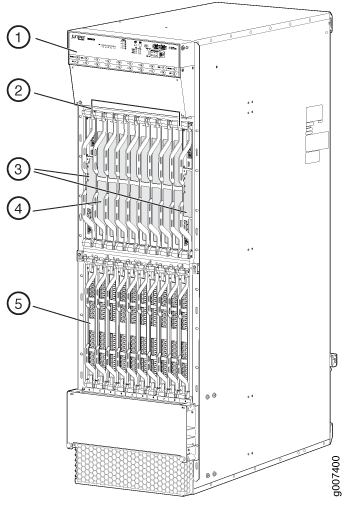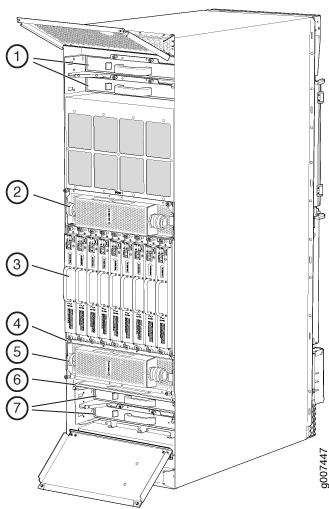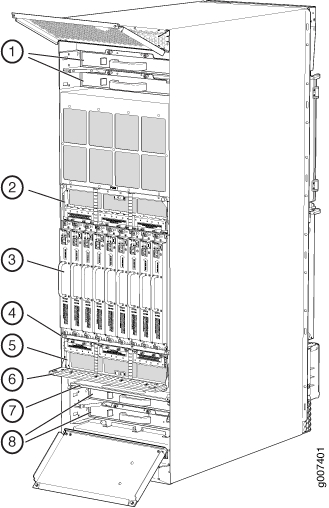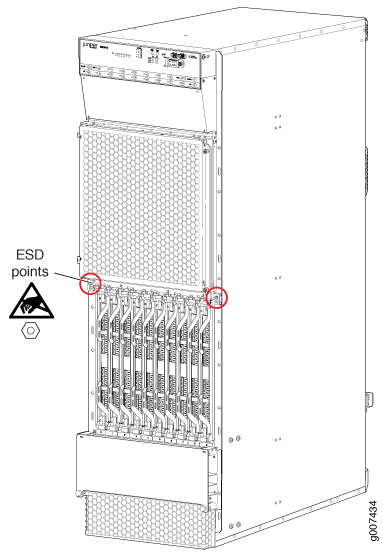MX2010 Chassis Description
The router chassis is a rigid sheet metal structure that houses all the other router components (see Figure 1, Figure 2, and Figure 3). The chassis measures 59.50 in. (151.13 cm) high, 36.20 in. (91.95 cm) deep, and 19 in. (48.26 cm) wide. The chassis can be installed in a standard 19-in. open-frame rack, four-post rack, or an enclosed cabinet.
There must be a minimum of 34-U of usable rack space when installing the MX2010 router into a 34-U rack.
If you are installing the MX2010 router into a network cabinet, make sure that no hardware, device, rack, or cabinet component obstructs the 34-U rack space from access during installation.
The chassis includes the following features (see Figure 1, Figure 2, and Figure 3).
-
Front-mounting flanges for mounting in a four-post rack or cabinet.
-
Center-mounting metal brackets for center-mounting in an open-frame rack (optional).
Before removing or installing components, attach an ESD strap to an ESD point, and place the other end of the strap around your bare wrist. Failure to use an ESD strap could result in damage to the hardware components.
The router must be connected to earth ground during normal operation.
The chassis with standard cable managers and EMI cover measures 59.50 in. (151.13 cm) high, 19 in. (48.26 cm) wide, and 36.20 in. (91.95 cm) deep (from the front-mounting flanges to the rear of the chassis). An extended cable manager extends the depth to 40.15 in. (102 cm).
One router can be installed in a 34-U or taller open-frame or four-post rack if the rack can support the combined weight, which can be greater than 985 lb (446.79 kg).
The dimensions also include the cable managers and EMI cover.

Remove field replacement units (FRUs) from the front of the MX2010 router before you install the router.
See Table 1 for information about the components on the front of the MX2010 router.
|
Component No. |
Component Description |
Slots |
Number of FRUs |
|---|---|---|---|
|
1 |
Craft interface |
– |
1 |
|
2 |
Card-cage air filter |
– |
1 |
|
3 |
Control Board and Routing Engine (CB-RE) |
0 and 1 |
2 |
|
4 |
Switch Fabric Boards (SFBs) |
0 through 7 |
8 |
|
5 |
MPCs with ADCs and MICs |
0 through 9 |
10 |
A combination card-cage cable manager and air filter is installed over the CB-REs and SFBs.
Remove field replacement units (FRUs) from the rear of the MX2010 router before you install the router.
See Table 2 for information about components on the back of an AC-powered MX2010 router.

|
Component No. |
Component Description |
Slots |
Number of FRUs |
|---|---|---|---|
|
1 |
Upper fan trays (two). |
Fan tray 2 and fan tray 3 (behind cage door) |
2 |
|
2 |
AC PDM—Three-phase delta or wye, or a single-phase AC PDM, or a high-voltage second-generation universal (HVAC/HVDC) PDM. Note:
The universal PDM accepts either an HVAC/HVDC input. |
PDM1/Input1 |
1 |
|
3 |
AC or a high-voltage second-generation universal (HVAC/HVDC) PSM. |
0 through 8 |
9 |
|
4 |
PSM air filter. |
– |
1 |
|
5 |
AC PDM—Three-phase delta or wye, or a single-phase AC PDM, or a high-voltage second-generation universal (HVAC/HVDC) PDM. |
PDM0/Input0 |
1 |
|
6 |
Fan tray air filter. |
– |
1 |
|
7 |
Lower fan trays (two). |
Fan tray 0 and fan tray 1 (behind access door) |
2 |

Remove field replacement units (FRUs) from the rear of the MX2010 router before you install the router.
See Table 3 for information about router components on the back of a DC-powered MX2010 router.
|
Component No. |
Component Description |
Slots |
Number of FRUs |
|---|---|---|---|
|
1 |
Upper fan trays (two). |
Fan tray 2 and fan tray 3 (behind cage door) |
2 |
|
2 |
DC PDM, DC PDM (240 V China), or a high-voltage second-generation universal (HVAC/HVDC) PDM. |
PDM1/Input1 |
1 |
|
3 |
DC PSM, DC PSM (240 V China), or a high-voltage second-generation universal (HVAC/HVDC) PSM. |
0 through 8 |
9 |
|
4 |
PSM air filter |
– |
1 |
|
5 |
DC PDM, DC PDM (240 V China), or a high-voltage second-generation universal (HVAC/HVDC) PDM. |
PDM0/Input0 |
1 |
|
6 |
DC cable manager (standard or extended). |
– |
2 |
|
7 |
Fan tray air filter. |
– |
1 |
|
8 |
Lower fan trays (two). |
Fan tray 0 and fan tray 1 (behind access door) |
2 |
The MX2010 router has two electrostatic discharge (ESD) points. These are located on either side of the MPCs on the front of the chassis (see Figure 4).

